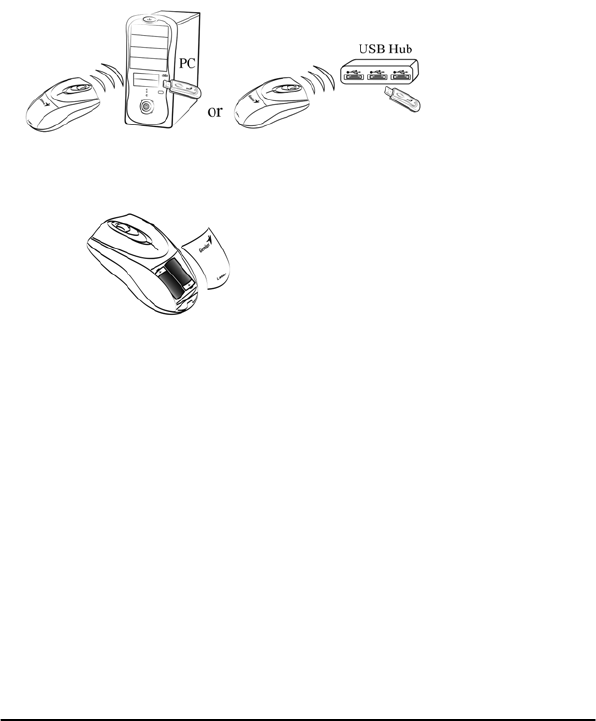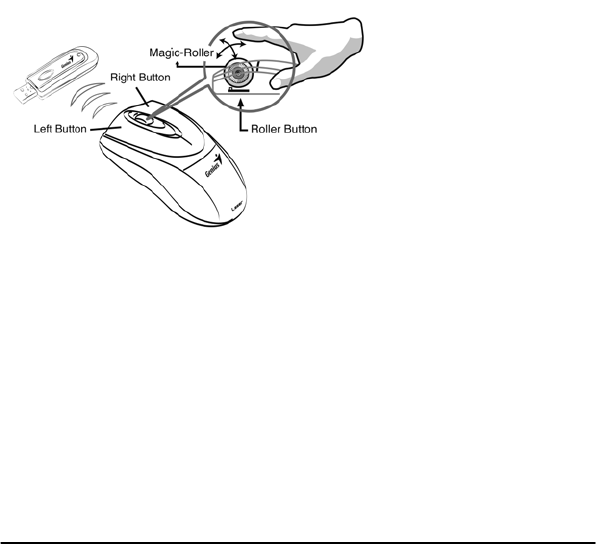KYE SYSTEMS GMZIA NAVIGATOR 620 LASER User Manual Nav 620 laser
KYE Systems Corp NAVIGATOR 620 LASER Nav 620 laser
USERS MANUAL

ENGLISH
1
Hardware Installation
1. You can connect the receiver to a USB port of a PC
2. Install two AA batteries in the mouse.
3. Turn on your computer. The mouse will now work.
Note: Class 1 Laser Product. Passed eye-safety regulation
(IEC 60825-1)
Warning: (Troubleshooting)
1. Please do not use wireless optical mouse on a desk which is made of
glass, mirror, iron, or black velvet. Also, a flat surface is necessary or
the optical sensor will be error easily. When you use wireless optical
mouse on a desk that is made of metal, try using a pad and reduce the
receiving distance.
2. The wireless optical mouse channel provides 256 ID-codes, and it
automatically selects the ID # for your mouse. You can only set up
one wireless optical mouse at a time. But if you have additional
wireless optical mouse sets in an area of 10 square meters, more
interference will occur between the receiver and your mouse.

ENGLISH
2
3. If you feel the mouse does not move smooth as usual, then the
batteries have lost their charge and need to be replaced. Remember do
not put the batteries in the wrong direction.
4. If the mouse does not have connection to the receiver, press the button
on the receiver first and then press the button under the mouse for
channel setting again.
Factory Setting
1. Left Button: Provides traditional mouse functions like click, double
click and drag.
2. Right Button: Provides traditional mouse click functions.
3. Magic-Roller: Press the “Magic-Roller” to surf the Internet and
Windows documents.

FCC ID: FSUGMZIA
FCC Compliance and Advisory Statement
This device complies with Part 15 of the FCC rules. Operation is subject to the following two
conditions:(1) this device may not cause harmful interference, and (2) this device must accept
any interference received, including interference that may cause undesired operation.
This equipment has been tested and found to comply with the limits for a Class B digital device,
according to Part 15 of the FCC rules. These limits are designed to provide reasonable
protection against harmful interference in a residential installation. This equipment generates,
uses and can radiate radio frequency energy and if not installed and used in accordance with
the instructions, may cause harmful interference to radio communications. However, there is
no guarantee that interference will not occur in a particular installation. If this equipment does
cause harmful interference to radio or television reception, which can be determined by turning
the equipment off and on, the user is encouraged to try correct the interference by one or more
of the following measures:
1.Reorient the receiving antenna.
2.Increase the separation between the equipment and receiver.
3.Connect the equipment into and outlet on a circuit different from that to which the receiver is
connected.
4.Consult the dealer or an experienced radio/TV technician for help.
Any special accessories needed for compliance must be specified in the instruction manual.
Warning: A shielded-type power cord is required in order to meet FCC emission limits and
also to prevent interference to the nearby radio and television reception. It is essential that
only the supplied power cord be used. Use only shielded cables to connect I/O devices to this
equipment.
CAUSION: Any changes or modifications not expressly approved by the party responsible for
compliance could void your authority to operate the equipment.